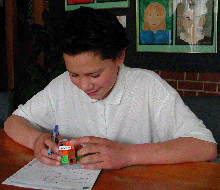Conceptual
understanding is a central goal of mathematics education. Mathematics
education is very much concerned with such matters as students’
confidence, interest and inventiveness in working with a range of
 |
|
|
mathematical
ideas. It is aims to help students develop their capacity for exploring,
applying and communicating their mathematical understandings within
real-world contexts.
National monitoring assessments invite students to demonstrate their
mathematical skills through a range of situations. These involve them
in asking questions, making connections, and applying understandings
and processes to novel as well as familiar situations. While confidence
and efficiency in basic knowledge of facts is assessed, there is also
a substantial focus on thinking, reasoning and problem-solving skills,
requiring more open tasks that allow students to demonstrate their
number sense, reason, make decisions and explain.
This chapter reports the results of sixty-three mathematics tasks administered
to individual Mäori students in both general education settings
and Mäori immersion settings. Twenty-three tasks were administered
in a videotaped one-to-one interview format, while the other forty tasks
were attempted in a station or independent format (students worked independently
on the tasks, with teacher support available if required for reading
and writing).
National monitoring results are reported task by task so that results
can be understood in relation to what the students were asked to do.
To allow comparisons of performance between the 2001 and 2005 assessments,
however, twenty-three of the sixty-three tasks have been designated link tasks.
Student performance data on these tasks are presented in this report,
but the tasks are described only in general terms because they will
be used again in 2005.
Five of the tasks were judged not to be suitable for comparisons of
the performance of Mäori students in general education and students
in Mäori immersion settings. The reasons for these exclusions are
presented in the commentaries accompanying the tasks.
Among the remaining fifty-eight tasks, Mäori students in general
education and students in Mäori immersion settings performed equally
well on thirty-four of the tasks. Mäori students in general education
scored statistically significantly higher on twenty-four tasks. These
differences occurred on 30 percent of the tasks in the Number strand,
42 percent of the tasks in the Measurement strand,
and 52 percent of the tasks in the remaining strands (Geometry,
Algebra and Statistics). All of these comparisons must
be interpreted with considerable caution, for the reasons discussed
in Chapter
2. |
